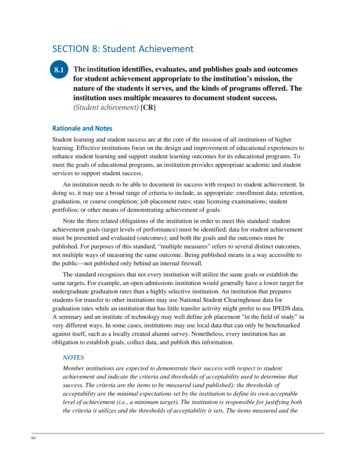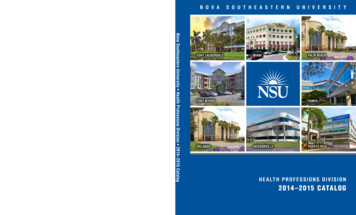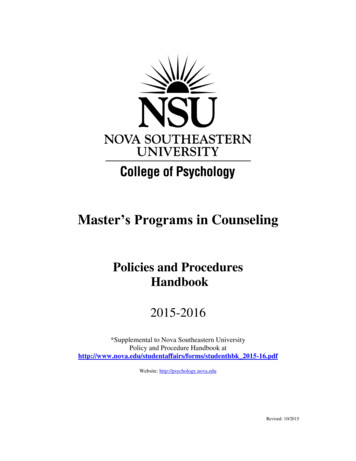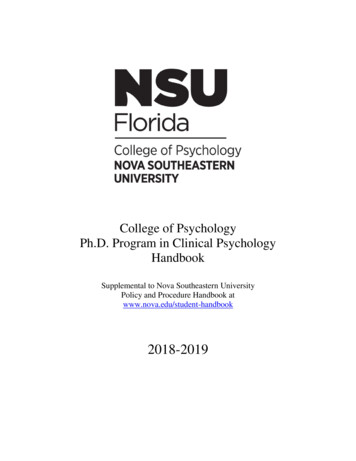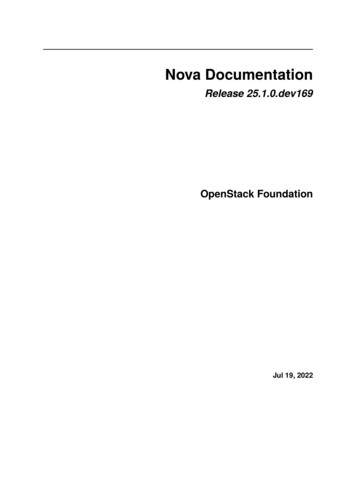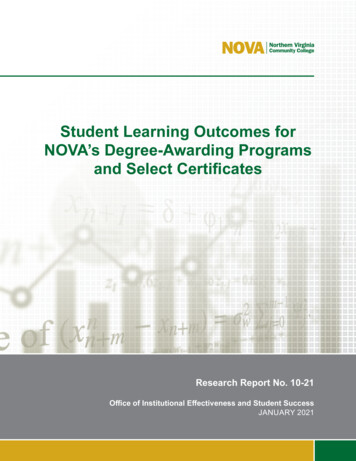
Transcription
Student Learning Outcomes forNOVA’s Degree-Awarding Programsand Select CertificatesResearch Report No. 10-21Office of Institutional Effectiveness and Student SuccessJANUARY 2021
NORTHERN VIRGINIA COMMUNITY COLLEGEOFFICE OF INSTITUTIONAL EFFECTIVENESS AND STUDENT SUCCESSThe purpose of the Office of Institutional Effectiveness and Student Success is to conductanalytical studies and provide information in support of institutional planning, policy formulation,and decision making. In addition, the office provides leadership and support in research relatedactivities to members of the NOVA community engaged in planning and evaluating the institution’ssuccess in accomplishing its mission.When citing data from this report, the Northern VirginiaCommunity College (NOVA) Office of Institutional Effectivenessand Student Success must be cited as the source.4001 Wakefield Chapel RoadAnnandale, VA 22003-3796(703) 323-3129www.nvcc.edu/oiess
Table of ContentsIntroduction . 1Accounting, A.A.S. . 2Administration of Justice, A.A.S. . 2Air Conditioning and Refrigeration, A.A.S. 3American Sign Language to English Interpretation, A.A.S. . 3Architecture Technology, A.A.S. . 3Automotive Technology, A.A.S. . 4Biotechnology, A.A.S. . 4Business Administration, A.S. . 5Business Management, A.A.S. . 5Cinema, A.F.A. 6Computer Science, A.S. . 6Construction Management Technology, A.A.S. . 6Contract Management, A.A.S. 7Cybersecurity, A.A.S. . 7Dental Assisting, Certificate . 7Dental Hygiene, A.A.S. . 8Diagnostic Medical Sonography, A.A.S. . 8Driver Education Instructor, C.S.C. . 8Early Childhood Development, A.A.S. . 9Emergency Medical Services, A.A.S. . 9Engineering, A.S. . 9Engineering Technology, A.A.S. .10General Studies, A.S.10General Studies: Health Sciences Specialization, A.S. .10Graphic Design, A.A.S. .11Health Information Management, A.A.S. .11Horticulture Technology, A.A.S. .11Hospitality Management, A.A.S. .12Information Systems Technology, A.A.S. .12Information Technology, A.S. .12i
Interior Design, A.A.S.13Liberal Arts, A.A. .13Liberal Arts: Theater, C.S.C. .13Medical Laboratory Technology, A.A.S. .14Medical Laboratory Technology: Phlebotomy, C.S.C. .14Music, A.A., A.A.A. .14Music Recording Technology, Certificate .14Nursing, A.A.S. .15Occupational Therapy Assistant, A.A.S. .15Paralegal Studies, A.A.S. .16Personal Training, C.S.C. .16Photography and Media, A.A.S. .16Physical Therapist Assistant, A.A.S. .17Professional Writing, Certificate .17Psychology, A.S. .17Public History and Historic Preservation, C.S.C. .18Radiography, A.A.S. .18Respiratory Therapy, A.A.S.18Science, A.S. .18Science: Mathematics Specialization, A.S.19Social Sciences, A.S. .19Social Sciences: Geospatial Specialization, A.S. .19Social Sciences: Teacher Education Specialization, A.S. .20Substance Abuse Rehabilitation Counselor, Certificate.20Veterinary Technology, A.A.S. .20Visual Art, A.F.A.21Welding: Basic Techniques, C.S.C.21ii
IntroductionAs part of the ongoing, nation-wide movement to increase accountability and transparency inhigher education, Northern Virginia Community College (NOVA) has made the assessment ofstudent learning outcomes (SLOs) a priority and has developed a college-wide culture ofassessment. Assessment is defined as “the ongoing process of: Establishing clear, measurable expected outcomes of student learning.Ensuring that students have sufficient opportunities to achieve those outcomes.Systematically gathering, analyzing, and interpreting evidence to determine how wellstudent learning matches our expectations.Using the resulting information to understand and improve student learning.” 1The assessment process at NOVA follows best practice in higher education assessment as wellas Southern Association of Colleges and Schools Commission on Colleges (SACS-COC)principles of accreditation. To begin the process of assessing student learning, programs mustfirst determine the student learning outcomes for their curriculum. Student learning outcomesare defined by NOVA as observable and measurable knowledge, skills, and attitudes/valuesthat students should achieve by the end of an educational program at NOVA. Thus, SLOs areeducational outcomes at the program level that students achieve as a result of completing theprogram of study.NOVA determined that all degree-awarding programs and select certificates must eachdesignate one faculty member to oversee the program’s/certificate’s assessment efforts. Inorder to provide support to programs and their designated assessment lead faculty, the Office ofAcademic Assessment, a unit within the College’s Office of Institutional Effectiveness andStudent Success (OIESS), regularly offers program-level meetings and college-wide workshopsdevoted to writing and assessing student learning outcomes as well as using results from SLOassessments to improve student learning. Since beginning these workshops in Spring 2009,each program has had at least one faculty member attend a session. Additionally, OIESSprovides a variety of online resources to support the SLO assessment process, found on theOffice of Academic Assessment website: https://www.nvcc.edu/oiess/academic-assessment/.In Fall 2009, assessment lead faculty members submitted student learning outcomes for theirrespective programs/certificates. Programs are asked to review their SLOs annually and updatethem when necessary. The most recent student learning outcomes have been compiled into thisreport. As explained above, establishing student learning outcomes is only the first step in theongoing cycle of assessment. Once student learning outcomes are established, programsdevelop methods to assess the student learning outcomes and gather data to make evidencebased decisions to improve student learning and the student experience at NOVA. Informationfrom these assessments are detailed each year in the Annual Planning and Evaluation Reports(APERs) for Instructional Programs; these reports can be found online lo-assessment/apers.html.1Linda Suskie, Assessing Student Learning: A Common Sense Guide. Anker Publishing, 2004.1
Student Learning Outcomes forNOVA’s Degree-Awarding Programsand Select CertificatesAccounting, A.A.S.Pathway: Business1. Be able to apply generally accepted accounting principles (GAAP).2. Perform all steps in the accounting process, including production of basic financialstatements.3. Be able to describe federal tax rules and apply them in preparing individual incometax returns.4. Be able to describe and make distinctions between the various business entities (i.e.,individuals, corporations and partnerships).5. Be able to use budgeting and product costing techniques and methods to evaluatebusiness operations.6. Be able to identify generally accepted auditing standards (GAAS) and the additionalrequirements imposed by the Sarbanes-Oxley Act.7. Know how to access the various technical and professional publications to use asreference sources.8. Be able to write and speak in English well enough to communicate accountingprocedures and concepts in a professional environment.9. Be able to describe and make distinctions between various accounting methods underU.S. GAAP and international financial reporting standards (IFRS).Administration of Justice, A.A.S.Pathway: Education and Public Service1. Name and describe the steps in the criminal adjudication process that involve thepolice, the courts, and corrections.2. Define the basic teachings of criminology, criminalistics, criminal justice, and forensicscience.3. Describe how crime is measured by the means of the Uniform Crime Report, NationalCrime Victimization Survey, Self-Report data, and the National Incident-BasedReporting System.4. Define generally, domestic and international terrorism, organized crime, classifiedinformation, and proprietary information.5. Identify and explain the major perspectives concerning crime causation including theclassical approach, biological approach, psychological approach, and the sociologicalapproach.6. Analyze an ethical dilemma or case study relating to a criminal justice issue.7. Articulate and explain the rights of citizens contained in the 4th, 5th, and 6thAmendments related to any one specific case within the criminal justice system.8. Explain basic investigative concepts relating to crime.9. Describe the elements of at least five (5) crimes.10. Demonstrate a basic understanding of law enforcement, the courts and thecorrections system.2
Air Conditioning and Refrigeration, A.A.S.Pathway: Engineering and Applied Technology1. Technical knowledge and capabilities: Design, install, maintain, and repair a basicresidential air conditioning and heating system.2. Problem prevention and solutions: Analyze an HVACR system’s current operation,evaluate its ability to adequately provide for the equipment owner’s comfortrequirements, and if necessary, formulate a strategy to correct any deficiencies.3. Presentation, manners, reliability, and safety: Demonstrate the ability to choose attireappropriate to the HVACR customers being served, utilize appropriate manners thatwill please a diverse population of possible customers, and demonstrate they may berelied upon to perform required duties properly, safely, and on time.4. Positive attitude and works well with others: Demonstrate a positive attitude and havea good working relationship with peers.5. Honesty, ethical behavior, and respect: Assess and demonstrate what is consideredhonest and ethical behavior in both personal and business situations. Demonstraterespect for others.6. Speech and written communication skills: Perform good communication skills, bothoral and written.7. Empathy with both customer and employer: Analyze customer concerns, empathizewith their position, and be able to differentiate between the demands of the customerand the position of the technician’s employer.8. Priorities and self-image: Demonstrate the ability to set priorities. Demonstrate anability to perform a personal analysis and evaluation in order to determine an accurateself-image and to formulate a program for improvement, if necessary.9. Productive: Perform good work habits, focus on the task-at-hand, and completeassignments on time.10. Continued improvement in knowledge and skills: Evaluate what additional skills orknowledge may be necessary for personal success, then choose a positive directionto attain them.American Sign Language to English Interpretation, A.A.S.Pathway: English and Deaf Studies1. Students will demonstrate the ability to interpret a 5-minute videotaped segment ofAmerican Sign Language into English with 80% accuracy.2. Students will demonstrate the ability to interpret a 5-minute videotaped segment ofEnglish into American Sign Language with 80% accuracy.3. Students will demonstrate the ability to transliterate a 5-minute videotaped segment ofContact Sign into English with 80% accuracy.4. Students will demonstrate the ability to transliterate a 5-minute videotaped segment ofEnglish into Contact Sign with 80% accuracy.5. Students will apply critical thinking to make ethical decisions regarding a variety ofsituations, guided by ethics standards of the profession.Architecture Technology, A.A.S.Pathway: Engineering and Applied Technology1. Students will be able to communicate graphically the architectural aspects of abuilding for the purposes of presentation and construction using manual drawing.2. Students will be able to describe how buildings are presently constructed.3
3. Students will be able to describe and analyze the ethics of designing sustainableenvironments.4. Students will be able to describe and analyze how buildings are structurallysupported.5. Students will be able to describe the systems of heating, cooling and electricaldistribution in buildings.6. Students will be able to describe how site characteristics influence the design andconstruction of buildings.7. Students will be able to communicate graphically the architectural aspects of abuilding for the purpose of presentation and construction using computer graphics.8. Students will be able to methodically design a building.Automotive Technology, A.A.S.Pathway: Engineering and Applied Technology1. Use measuring tools to skillfully and accurately diagnose the internal combustionengine.2. Diagnose transmission/transaxle gear reduction/multiplication concerns using driving,driven, and held member (power flow) principles using a range reference chart.3. Measure drive pinion bearing preload and ring gear backlash and backlash variationto compare to specifications in order to determine necessary corrective actions.4. Perform preliminary inspections and procedures needed to prepare a vehicle for afour-wheel alignment by checking and assessing vehicle ride height, tire condition,and inflation.5. Inspect and measure a rotor with a dial indicator and micrometer to determine theserviceability of the rotor.6. Apply electrical theory using wiring diagrams and schematics to diagnose and repairautomotive electrical circuits.7. Research applicable vehicle and service information, vehicle service history, serviceprecautions, technical service bulletins, and components for automotive heating andventilation systems.8. Retrieve diagnostic trouble codes and monitor status using a scan tool. Using thescan tool data and wiring diagrams, determine the next logical step in the drivabilitydiagnostic process.Biotechnology, A.A.S.Pathway: Life Sciences1. Explain the fundamental scientific concepts in biotechnology.2. Apply the scientific method including: planning an experiment, collecting data, andanalyzing and interpreting data.3. Demonstrate proficiency in standard lab procedures and in the use of basic labequipment.4. Effectively communicate scientific concepts, strategies, and opinions in written andoral formats.5. Describe the ethical and regulatory aspects of the biotechnology industry.6. Describe the business and legal aspects of the biotechnology industry.7. Demonstrate professional communication and interpersonal skills necessary forworking in a collaborative environment.8. Demonstrate proficiency in standard lab calculations.4
Business Administration, A.S.Pathway: Business1. Students will be able to identify the various forms of business ownership (soleproprietorship, partnership and corporation) and the multiple ways of getting abusiness started.2. Students will be able to calculate the basic impact of marginal cost for the productionof goods in a capitalist system.3. Students will be able to describe the various theories related to the development ofleadership skills, motivation techniques, teamwork, and effective communication.4. Students will be able to construct the basic elements of a balance sheet and incomestatement utilizing the appropriate accounting equations.5. Students will be able to utilize computer skills through the Internet, word processing,and other productivity software to construct reports and presentations in the study ofcurrent business practices.6. Students will apply the planning, organizing, leading, and control processes ofmanagement in identifying the various theories related to the development ofleadership skills.7. Students will be able to identify the properties of market equilibrium and the creationof market shortages and surpluses within the scope of supply and demand.8. Students will be able to identify the factors of production in the creation of goods andservices in an economic society.9. Students will demonstrate skills important for successful transition into the workplaceand pursuit of further education.10. Students will be able to generate a summary report of sample data using graphs anddescriptive measures.Business Management, A.A.S.Pathway: Business1. Students will be able to identify the various forms of business ownership (soleproprietorship, partnership and corporation) and the multiple ways of getting abusiness started.2. Students will be able to identify parties in a legal dispute within the fundamental typesof business organizations (sole proprietorship, franchise, partnership, corporation,Limited Liability Company, and limited liability partnership).3. Students will be able describe the various theories related to the development ofleadership skills, motivation techniques, teamwork, and effective communication.4. Students will be able to construct the basic elements of a balance sheet and incomestatement utilizing the appropriate accounting equations.5. Students will apply the planning, organizing, leading, and control processes ofmanagement in identifying the various theories related to the development ofleadership skills.6. Students will be able to identify the factors of production in the creation of goods andservices in an economic society.7. Students will be able to differentiate the ethical codes of compliance and integrityused by business organizations.8. Students will be able to identify various challenges facing the management of humanresources.9. Students will be able to generate a summary report of sample data using graphs anddescriptive measures.5
10. Students will be able to describe the elements of the marketing mix (product, price,place and promotion) and their use to achieve customer satisfaction.Cinema, A.F.A.Pathway: Visual, Performing, and Media Arts1. Evaluate the theories, principles, and/or practices of cinema.2. Critically analyze film.3. Critically evaluate film scholarship using basic research methods.4. Apply pre-and post-production practices effectively.5. Integrate knowledge of professional industry standards and practices.6. Develop and produce original and time-based content.7. Incorporate visual language into cinema projects.8. Work effectively in groups.Computer Science, A.S.Pathway: Information Technology and Computer Science1. Demonstrate techniques for problem analysis and algorithm design.2. Write computer programs using fundamental software development skills.3. Perform elementary file and directory-related activities using GUIs and command-lineinterfaces.4. Demonstrate proficiency in mathematical modeling using a high or low levelprogramming language.5. Write computer programs using object–oriented programming features6. Demonstrate critical thinking by applying appropriate data structures and AbstractData Types (ADTs).7. Show the ability to work in groups to design and execute programs to solve problems.8. Design fundamental logic circuits.9. Identify the functions of basic and advanced computer hardware architecture.Construction Management Technology, A.A.S.Pathway: Engineering and Applied Technology1. Students will communicate effectively consistent with career requirements of theconstruction management industry (orally and written).2. Students will accurately interpret construction documentation.3. Students will identify characteristics of basic construction materials and explain theirapplication in the construction industry.4. Students will accurately estimate construction costs.5. Students will accurately prepare construction plans and schedules utilizing industrystandards.6. Students will identify safe construction practices.7. Students will be able to interpret construction related contractual and legalrequirements.8. Students will perform surveying calculations necessary for site layout.9. Students will successfully identify and demonstrate skills necessary to manage humanresources related to the construction industry.6
Contract Management, A.A.S.Pathway: Business1. Students will be able to conduct market research in accordance with the FederalAcquisition Regulation (FAR).2. Students will be able to apply sound strategic acquisition planning so that informedbusiness decisions can be made on behalf of the government.3. Students will be able to prepare project schedules for contract implementation.4. Students will be able to apply fundamental contracting techniques by utilizing thebasic Federal contracting processes: i.e., cost estimation procedures, requirementdeterminations, and characteristics of best value analysis.5. Students will be able to independently apply contract administration programs insupport of Federal contracts.6. Students will be able to conduct cost and price analysis of request for proposal inorder to establish negotiation positions.Cybersecurity, A.A.S.Pathway: Information Technology and Computer Science1. Manipulate data into meaningful information.2. Create simple scripts/programs to automate and perform simple operations, includinghow to perform basic security practices in developing scripts/programs (e.g. boundschecking, input validation).3. Describe current threats and explain how to continuously monitor the threats that maybe present in the cyber realm.4. Identify the options available to mitigate threats within a system.5. Apply basic security design fundamentals that help create systems that aretrustworthy.6. Describe the basic concepts of information assurance fundamentals.7. Explain where and how cryptography is used.8. Describe the basic components in an information technology system and their roles insystem operation.9. Identify network components and describe how they interact.10. Explain basic operations involved in system administration11. Be able to describe memory types and allocation methods.Dental Assisting, CertificatePathway: Health Sciences1. Students will be able to chart oral conditions.2. Students will be able to perform chair side dental assisting duties.3. Students will be able to perform dental assisting expanded duties.4. Students will be able to perform dental laboratory procedures.5. Students will be able to perform dental practice management procedures.6. Students will be able to expose diagnostic dental radiographic surveys.7. Students will be able to manage dental protocols for infection control practices andbiohazard waste.8. Students will be able to identify legal and ethical aspects of clinical practice.7
Dental Hygiene, A.A.S.Pathway: Health Sciences1. Assess a patient’s oral health status.2. Plan and document a patient’s treatment needs.3. Evaluate the outcomes of treatment and determine subsequent treatment needs.4. Expose radiographs.5. Interpret radiographs.6. Communicate the provision of oral health care services with diverse populationgroups.7. Evaluate and apply scientific literature based on critical analysis of research, scientifictheories, and standards of care as a basis for evidence-based practice.8. Provide care to a diverse population who present with slight, moderate, and advancedperiodontal disease and other oral conditions.9. Recognize the importance for discerning and managing ethical issues consistent withprofessional code of ethics.Diagnostic Medical Sonography, A.A.S.Pathway: Health Sciences1. Provide high-quality patient care in an ethical, legal, safe, and effective manner.2. Integrate patient history, current medical condition, and sonographic findings toprovide accurate diagnostic information.3. Apply principles of ultrasound physics in the operation of medical sonographicequipment to recognize and perform image optimization techniques.4. Identify relational anatomy, proper diagnostic imaging techniques, and sonographicappearances of anatomical structures.5. Evaluate ultrasound images for diagnostic information and pertinent technical details.6. Practice professional work habits and appropriate interpersonal relationships in aclinical setting when working with clinical staff, other healthcare providers, and/orphysicians.Driver Education Instructor, C.S.C.Pathway: Education and Public Service1. Students will distinguish VA driving rules and laws that are necessary to teach DriversEducation in Virginia using the VADETS final exam.2. Students will be able to create a competent classroom lesson plan for DriverEducation students under the age of 19.3. Students will be able to create a competent behind the wheel lesson plan for DriverEducation students under the age of 19.4. Students will be able to create a skills worksheet/outline to be used for their lessons inbehind the wheel.5. Students will be able to design a proper behind the wheel driving route.6. Students will demonstrate proficiency in their own driving skills as demonstrated onthe range.8
Early Childhood Development, A.A.S.Pathway: Education and Public Service1. Apply developmental knowledge to the crea
3. Describe how crime is measured by the means of the Uniform Crime Report, National Crime Victimization Survey, Self-Report data, and the National Incident-Based Reporting System. 4. Define generally, domestic and international terrorism, organized crime, classified information, and proprietary information. 5.







